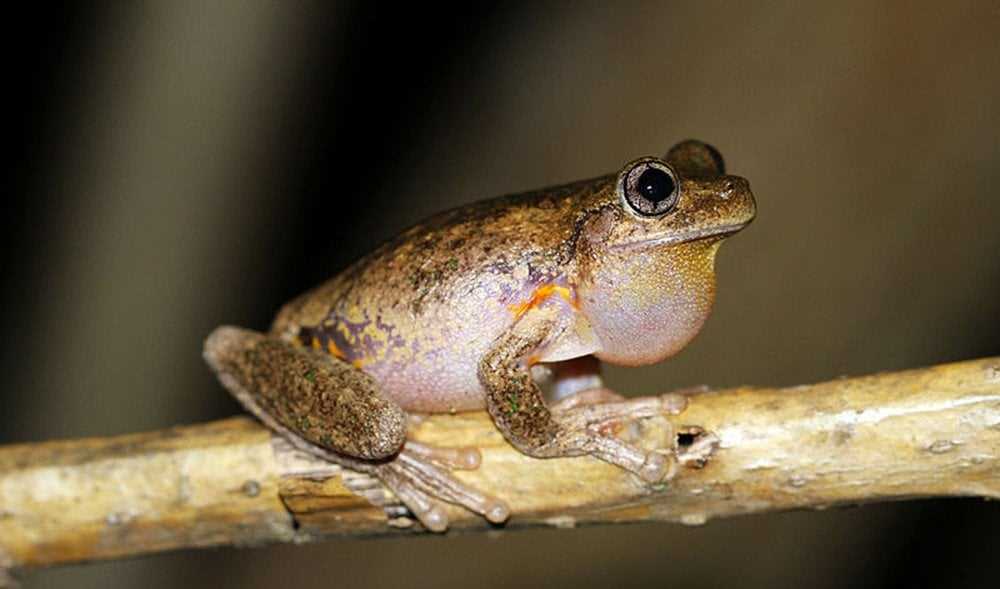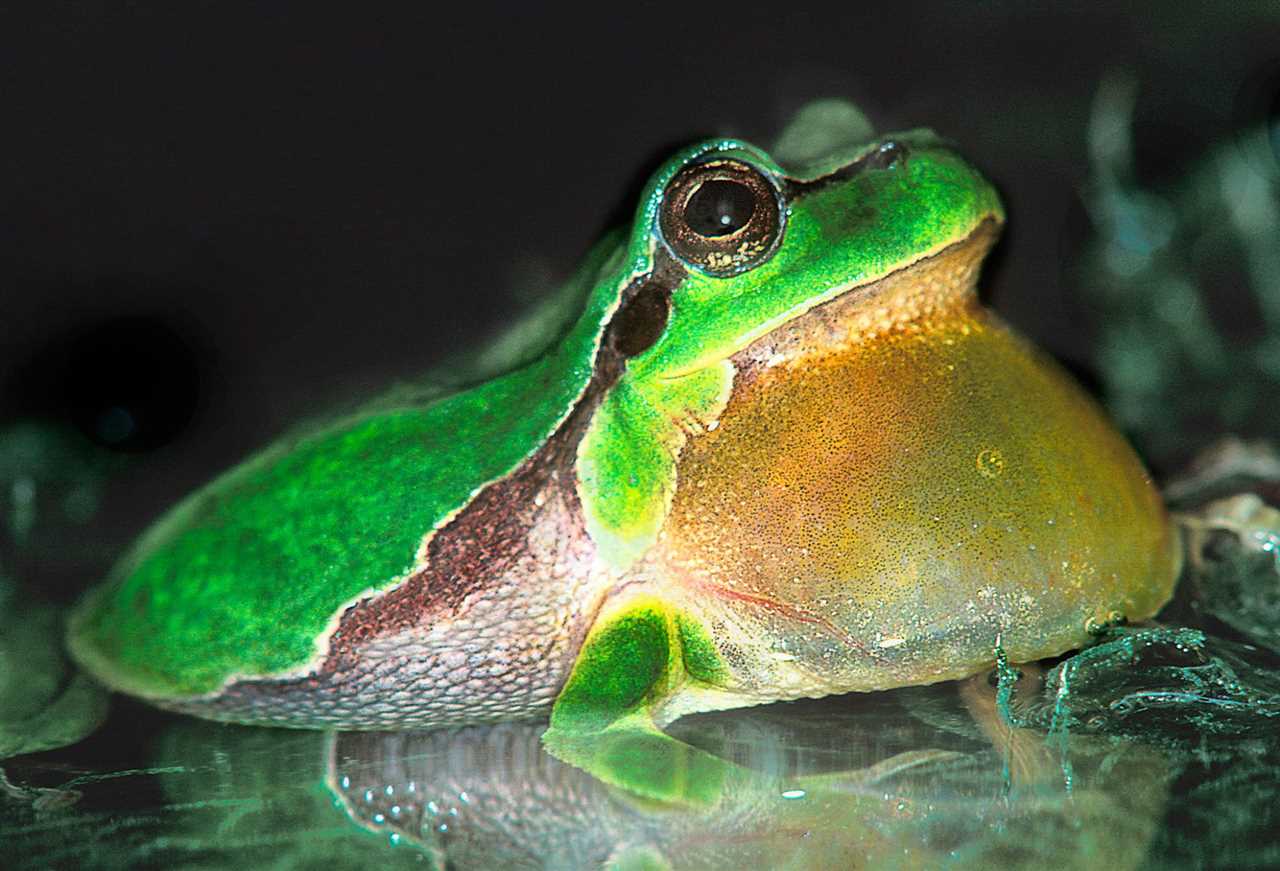Male frogs are especially known for their vocal abilities. They produce sounds by inflating their vocal sacs and expelling air. Each species of frog has its own distinct call, which helps them to communicate with other frogs and establish their presence in their environments.
Some frog calls are melodic and soothing, resembling musical tunes that echo through the night. Others are short and sharp, acting as warning signals to predators or territorial rivals. Some species of frogs produce calls that are so loud that they can be heard from great distances.
Croaking: The Classic Sound of Frogs
Croaking is a vocalization produced by male frogs in order to attract females and establish their territory. It is a deep, resonant sound that carries over long distances. The main purpose of croaking is to communicate and advertise the presence of a male frog to potential mates.
Each species of frog has its own distinct croaking sound, which allows researchers and enthusiasts to identify different frog species based on their calls. The croaking sound is produced by the vibration of vocal sacs, which are inflatable pouches located on the sides of a frog’s head.
Some species of frogs produce a soft and gentle croaking sound, while others have a louder and more robust call. The duration and frequency of croaking can also vary, with some frogs producing short bursts of croaks, while others have a continuous call.
Croaking for Mating and Territory
The primary purpose of croaking is to attract female frogs and establish territory. Male frogs will often gather in a specific area, such as a pond or wetland, and engage in a chorus of croaking to increase their chances of attracting a mate.
The loudness and intensity of croaking can signal the size and strength of a male frog, making it a form of competition among males. The male with the loudest and most persistent croak is more likely to attract a female and successfully reproduce.
Croaking is most common during the breeding season when male frogs are actively seeking mates. It is a highly efficient and effective method of communication, allowing frogs to attract females from a distance and establish their dominance over other males.
Overall, croaking is an essential part of a frog’s life cycle and plays a crucial role in their reproductive success. It is a classic sound associated with frogs and adds to the ambiance of natural habitats where frogs are present.
Ribbiting: A Common Vocalization of Frogs
The Sound of Ribbiting
Ribbiting is the croaking sound that is characteristic of many frog species. It is produced by male frogs during the breeding season as a way to attract females and establish their territory. The sound is created by the males inflating their vocal sacs and expelling air. The result is a deep, resonant croak that can be heard over long distances.
Why do Frogs Ribbit?
The primary purpose of ribbiting is for mating and communication. Male frogs use their vocalizations to attract females and compete with other males for breeding rights. Each species of frog has a unique ribbiting call, allowing females to identify potential mates and males to recognize their rivals.
It’s a way for frogs to advertise their presence in the environment and signal their availability for mating.
Variations in Ribbiting

Ribbiting sounds can vary in pitch, duration, and intensity among different frog species. Some frogs produce high-pitched ribbiting calls, while others have a lower and more resonant sound. The duration of the call can also vary, ranging from short bursts to continuous ribbiting that goes on for several minutes.
This variety in vocalizations helps to distinguish between different frog species and allows them to coexist without confusion.
Other Vocalizations of Frogs
In addition to ribbiting, frogs can produce a wide range of other sounds. Some frogs chirp, creating delicate and rhythmic sounds. Others grunt, creating deep, rumbling calls. There are also frogs that trill, emitting melodic and pleasing sounds. Certain frog species whistle or screech, producing unique vocalizations that are distinctive to their species. Some frogs even bark or squeal, making unusual and high-pitched calls, especially when they are in distress.
These various vocalizations help frogs communicate with each other, protect their territory, and ensure successful reproduction.
Chirping: A Delicate Sound Produced by Some Frog Species
Chirping is a unique noise that some frog species make. It is a delicate sound that can be heard in various environments, including forests, wetlands, and gardens. This particular vocalization is produced by male frogs during the mating season as a way to attract females.
How do frogs produce chirping sounds?
Chirping sounds are created by a unique mechanism in the vocal sac of male frogs. The vocal sac acts as a resonating chamber, amplifying the sound produced by the frog. When the male frog fills its vocal sac with air and releases it rapidly, it creates a high-pitched, chirping noise that can carry over long distances.
Frogs that produce chirping sounds have specialized vocal cords that allow them to produce distinct and unique calls. Each species has its own specific chirping pattern, which helps to differentiate one species from another.
What is the purpose of chirping?
The primary purpose of chirping is to attract female frogs for mating. Male frogs use their chirping calls to establish territories and to signal their presence to nearby females. The volume and frequency of the chirping can vary depending on the species and the individual frog.
Chirping is also used as a form of communication between males. It can be a way for male frogs to determine the presence of rivals and to establish dominance within their territory. By analyzing the different chirping sounds, frog researchers and enthusiasts can identify different species and individuals.
Examples of frogs that chirp

| Species | Common Name | Chirping Sound |
|---|---|---|
| Pseudacris crucifer | Spring Peeper | High-pitched, loud chirping |
| Pseudacris regilla | Pacific Tree Frog | Bird-like chirping |
These are just a few examples of frogs that produce chirping sounds. There are many other species around the world that use this unique vocalization to communicate and attract mates.
Trilling: A Pleasing and Melodic Sound by Arboreal Frogs

The trilling sound can vary in pitch and duration depending on the species of frog. It is often characterized by a series of rapid and high-pitched notes that are repeated in a rhythmic pattern. The sound is often described as being similar to the trilling of a bird or the sound of a musical instrument.
Arboreal frogs use trilling as a way to communicate with each other. The sound can serve a variety of purposes, including attracting a mate, defending territory, or signaling danger. Male frogs often trill to attract females during the breeding season. The females, in turn, are attracted to the males with the most impressive trills.
The trilling sound is not only pleasing to human ears but also serves an important ecological function. It helps to maintain the balance of ecosystems by regulating populations of insects and other small creatures. Many arboreal frogs feed on insects, so their trilling can help to control insect populations.
The trilling sound is a true testament to the unique and fascinating world of frogs. It is a sound that evokes a sense of tranquility and harmony in nature. So, next time you hear the melodic trilling of an arboreal frog, take a moment to appreciate the beauty of nature’s symphony.
Trilling: A Pleasing and Melodic Sound by Arboreal Frogs
How do arboreal frogs make trilling sounds?
Arboreal frogs have specialized vocal sacs, which are flexible and stretchy structures located under their mouths. When these frogs inhale, air enters their lungs and vocal sacs. To produce the trilling sound, the frogs force air out of their lungs and into the vocal sacs. The rapid vibration of the sacs creates a series of high-pitched notes, which combine to form the trilling sound.
Why do arboreal frogs trill?
Trilling is a form of vocalization used by arboreal frogs primarily for communication purposes. Male frogs often produce trilling sounds to attract mates and establish their territory. The trilling sound serves as a signal to other frogs, indicating the presence of a healthy and desirable mate or indicating an established territory. Female frogs may also use trilling to communicate their receptiveness to mating.
What is the significance of the trilling sound?
The trilling sound made by arboreal frogs is significant in several ways. Firstly, it helps frogs attract potential mates during the breeding season. The loud and distinctive trilling sound carries over long distances, allowing male frogs to advertise their willingness to mate to females in the area. Additionally, the trilling sound serves as a means of communication between neighboring frogs, signaling the boundaries of their territories and establishing dominance.
Whistling: Unique Vocalizations of Certain Frog Species
One of the unique sounds that frogs make is whistling. While not as commonly heard as croaking or ribbiting, whistling is a distinctive vocalization produced by certain frog species.
Whistling sounds are often described as high-pitched and musical, resembling the sound of a whistle or a flute. They are typically produced by male frogs during the breeding season as a way to attract a mate or establish territory.
These specialized vocalizations require a particular anatomy of the frog’s vocal sacs and vocal cords. By inflating their vocal sacs and modulating the airflow through their vocal cords, frogs are able to produce distinct whistling sounds.
Whistling Frogs
Another example is the Bornean treefrog (Rhacophorus nigropalmatus), found in the rainforests of Southeast Asia. These frogs have a unique whistling call that can vary in pitch and intensity.
It is believed that whistling calls serve as a way for male frogs to communicate with other individuals of their species, especially during the breeding season. The variations in pitch and intensity may help frogs distinguish between different individuals or communicate specific messages.
Conclusion
The loud calls of tree frogs
The purpose of this vocalization is to attract mates and establish territory. Male tree frogs use their vocal sacs, a specialized throat pouch, to amplify their calls. By inflating and deflating these sacs, they are able to produce a series of loud and repetitive screeches.
The loud calls of tree frogs can be quite impressive, especially when a chorus of frogs begins calling together. Their screeches can create a cacophony of noise that fills the air, making it almost impossible to ignore their presence.
So, the next time you find yourself in a natural area and hear a piercing screech, don’t be startled. It’s just the loud calls of tree frogs, announcing their presence and trying to find that special someone.
Barking: Unusual Vocalizations of Some Frog Species
Barking sounds can vary in pitch and duration depending on the species of frog. Some frogs emit short, sharp barks, while others produce longer, deeper barking sounds. These sounds can be quite loud and can travel over long distances.
Scientists believe that frogs bark for different reasons. It can be a warning signal to other frogs, alerting them to potential threats or dangers in the environment. Barking can also be a way for frogs to establish their territory or communicate with potential mates.
One example of a frog species known for its barking vocalizations is the Casque-headed Treefrog. These frogs are native to Central and South America and have a distinctive call that resembles the barking of a small dog. Their barking can be heard echoing through the rainforests, especially during mating season.
Squealing: High-Pitched Calls of Frogs in Distress
The squealing sound is often described as piercing and shrill, similar to the sound of a small animal in pain or being attacked. It is a distress call that serves as a warning to other frogs and potential predators in the area.
When a frog feels threatened or is being attacked, it will emit this high-pitched sound to alert nearby frogs of the danger. This can be a signal for other frogs to stay away or to come to the aid of the distressed frog.
Interestingly, the sound of a frog squealing can vary slightly depending on the species. Some may produce a single high-pitched squeal, while others may emit a series of squeals in rapid succession. The volume and intensity of the squealing can also vary, depending on the level of distress the frog is experiencing.
Squealing is not a vocalization that is commonly heard in everyday frog communication. It is a sound that is reserved for situations of extreme stress or danger. Frogs use a variety of other calls, such as croaking, ribbiting, and chirping, for regular communication and attracting mates.
Why do frogs squeal?
There are several reasons why frogs may squeal. First and foremost, it is a defense mechanism. When a frog feels threatened or in danger, it will emit this loud and piercing sound as a way to startle and deter predators.
Additionally, squealing can also serve as a distress call to other frogs in the area. By emitting this high-pitched sound, a frog can attract the attention of other frogs and potentially receive help or support.
Lastly, squealing can also be a way for a frog to communicate its state of vulnerability. It is a way for the frog to signal that it is in a compromised position and in need of assistance or protection.
Conclusion

I’m Lena Adams—a product of an unconventional upbringing in the African wilderness. My father, a daring explorer of African wildlife, sparked my fascination with reptiles, a passion that intertwined with the tragic loss of my mother during an expedition, leaving an indelible mark on my life. Driven to understand the creatures that captivated my parents, I embarked on my journey, sharing insights about reptiles, frogs, and lizards on my website. Through my explorations and conservation efforts, I honour my family’s legacy while seeking connections—to the creatures, nature, and the mother whose presence I yearn to understand.
